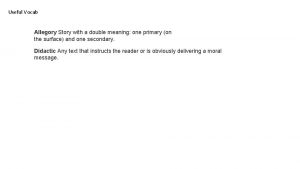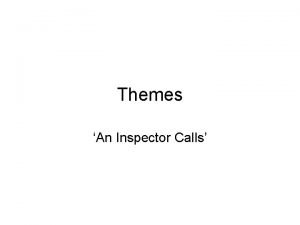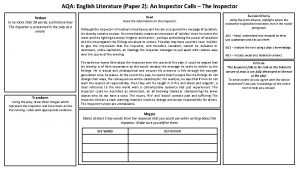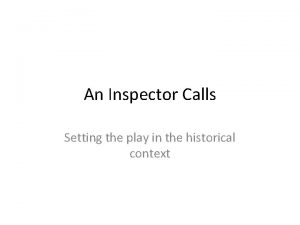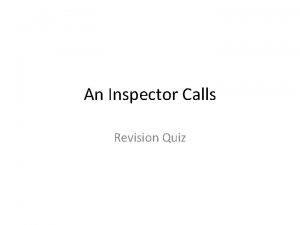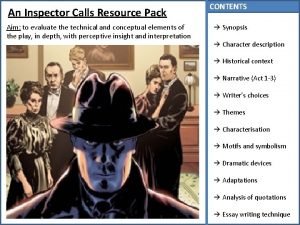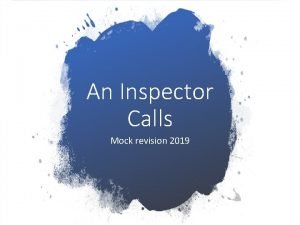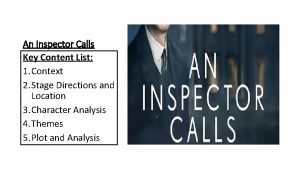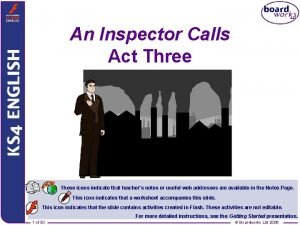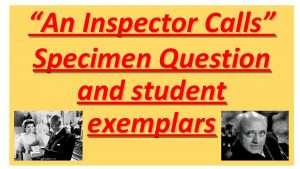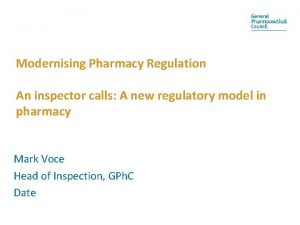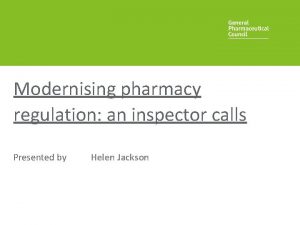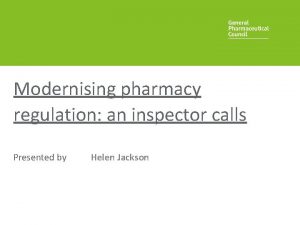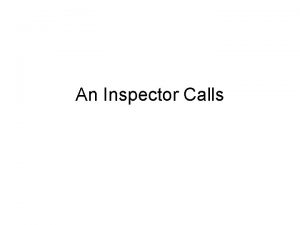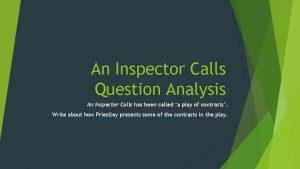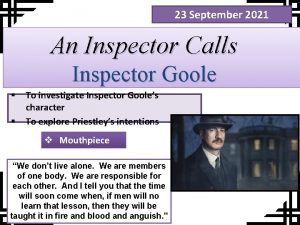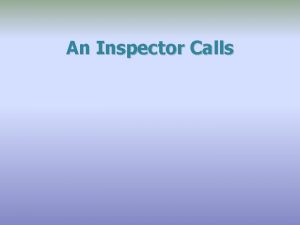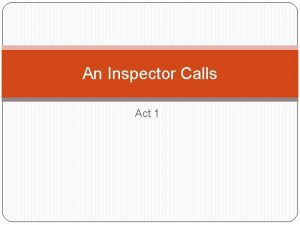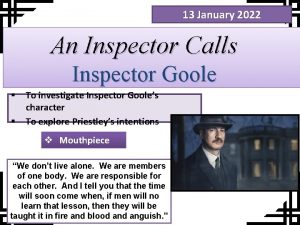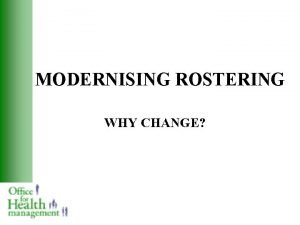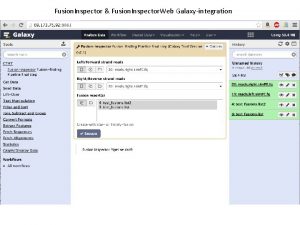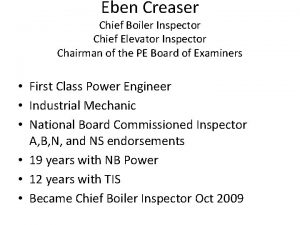Modernising Pharmacy Regulation An inspector calls A new

















- Slides: 17

Modernising Pharmacy Regulation An inspector calls: A new regulatory model in pharmacy Deborah Hylands Inspector, GPh. C 19 th February 2014

Our statutory role “To protect, promote and maintain the health, safety and wellbeing of members of the public. . . by ensuring that registrants, and those persons carrying on a retail pharmacy business. . . Adhere to such standards as the Council considers necessary. . . ”

How? • Education: Approving qualifications for pharmacists and pharmacy technicians and accrediting education and training providers • Registration: Maintaining the register of pharmacists, pharmacy technicians and pharmacy premises • Setting standards: For conduct, ethics and performance; education and training; and continuing professional development (CPD); and standards for the safe and effective practice of pharmacy at registered pharmacies • Fitness to practise: Ensuring professionals on our register are fit to practise and dealing fairly and proportionately with complaints and concerns.

About us Professional regulation ‘System’ regulation • Regulating pharmacy professionals through standards for conduct, ethics and performance • Taking action where the fitness to practise of a registered pharmacy professional may be impaired • Regulating pharmacies through standards for registered pharmacies • Requiring owners and superintendents to secure compliance with those standards • If the standards not met, registration of that pharmacy professional at stake • Individual professional accountability • Analogous to GMC/NMC • If the standards are not met, registration of the pharmacy is at stake • Organisational accountability (through owner/superintendent) • Analogous to Care Quality Commission

Summing up our approach Council’s vision is for pharmacy regulation to play its part in improving quality in pharmacy practice and ultimately health and well-being in England, Scotland Wales

STANDARDS FOR REGISTERED PHARMACIES

Our approach to standard setting • A focus on outcomes, not prescriptive rules: set out what safe and effective pharmacy practice looks like for patients • Leaves it to pharmacy professionals - they are the experts - to decide how to deliver that safe and effective practice • New accountability structure: being accountable for what they are responsible for which is why pharmacy owners and superintendents are accountable for meeting the new standards

So what do we mean by outcome. . . • An outcome is the ultimate result of something being in place or for an action being undertaken • Example: Putting in a pedestrian crossing is an output – People are safer crossing the road is the outcome – Easier for those with mobility difficulties to get about is also the outcome

What does this mean in pharmacy? • In practice, this means pharmacies should have as their top priority, patients and keeping them safe, and should be able to show they do that, every day • It will be up to pharmacies to provide the evidence and examples in whatever way they choose

Standards for registered pharmacies: Five principles • Principle 1 – looks at how risk is managed • Principle 2 – looks at how people / staff are managed • Principle 3 – looks at how the building / premises is managed • Principle 4 – is about how pharmacy services are delivered • Principle 5 – is about the equipment and facilities they have and use to deliver services

Meeting the standards • Pharmacies should meet the standards every day – not just when an inspector calls • Our inspections are just one way that we assure that pharmacies are keeping patients and the public safe • For instance, owners and superintendents renewing the registration of their pharmacies need to declare that they have read the standards and undertake to meet them

How will we know the standards are being met? • Prototype of our approach to inspecting against the standards running from 4 November • Testing four indicative judgements of performance – poor, satisfactory, good and excellent – Inspection outcome decision framework to aid inspectors in making consistent judgements • Improvement action plans operational • Pharmacy owner and superintendent will get a report, but no public reports during prototype phase • Strategic relationship management has started

Inspection labels and descriptions Poor pharmacy Good pharmacy • has failed to achieve the pharmacy standards overall. There are major concerns that require immediate improvement. • achieves all standards consistently well and has systematic review arrangements that ensure continual improvement in the quality and safety of pharmacy services delivered to patients. Satisfactory pharmacy Excellent pharmacy • achieves all or the majority of standards and may require some improvement action to address minor issues. • demonstrates all the hallmarks of a good pharmacy. In addition, it is either innovative and/or provides unique services that meet the health needs of the local community and that other pharmacies might learn from.

Action learning testing – what we’ve done • On site test inspections in 3 phases • Around 150 full test inspections completed • 65: 35 split independents to multiples Snapshot of what we found • Most inspections identified a number of relatively minor issues • More rigorous assessment triangulation of evidence • New potential risks identified • Quite a low level of awareness of new premises standards in general • Language of governance and risk management is quite challenging

Early indicative inspection trends from testing Most common standards not met from early testing: • • • Management of medicines & medical devices (4. 3) Risk management identification & management (1. 1) Records management (1. 6) Risk reviewed & monitored (1. 2) Pharmacy services managed & delivered safely (4. 2) Premises safe, clean & properly maintained (3. 1) Most common combinations of standards not met: • 1. 1 & 1. 2 • 4. 2 & 4. 3 • 1. 1, 1. 2, 4. 2 & 4. 3

What feedback was received? • Pharmacists value the instant feedback • Positive engagement with staff team • ‘Show and tell’ approach welcomed • Seen as a learning and development opportunity for all pharmacy team • Inspector on site for longer

Resources • We have a new resource with more information at http: //pharmacyregulation. org/pharmacystandardsguide
 Is an inspector calls an allegory
Is an inspector calls an allegory An inspector calls generation gap
An inspector calls generation gap An inspector calls characterization
An inspector calls characterization English lit paper 1 an inspector calls
English lit paper 1 an inspector calls 1912 strikes an inspector calls
1912 strikes an inspector calls Fairly easy manners
Fairly easy manners Look mummy isn't it a beauty analysis
Look mummy isn't it a beauty analysis An inspector calls character
An inspector calls character An inspector calls act 2
An inspector calls act 2 An inspector calls recall questions
An inspector calls recall questions Context of an inspector calls
Context of an inspector calls An inspector calls plot
An inspector calls plot Inspector calls wordsearch
Inspector calls wordsearch An inspector calls starter activities
An inspector calls starter activities How does sheila change in an inspector calls
How does sheila change in an inspector calls Kahoot an inspector calls
Kahoot an inspector calls Rose tinted glasses an inspector calls
Rose tinted glasses an inspector calls Generation gap in an inspector calls
Generation gap in an inspector calls
